GPRS Sensor Node Battery Life Span Prediction Based on Received Signal Quality: Experimental Study
Abstract
1. Introduction
- Our sensor node is not moving,
- The rate with which the sensor node is transmitting data is fixed,
- All sensors in the network are not moving, and
2. Related Works
3. Material and Methods
3.1. Current Measuring: Part 1
3.2. Sensor Node: Part 2
3.3. Important Specification about SIM800L
3.4. Useful AT Command for This Research Paper
3.5. Battery/Network Life Span
3.6. Experiment Setup
3.7. Data Acquisition Part
3.7.1. Scenario1: Reference Current Acquisition
3.7.2. Scenario2: GSM Current Acquisition
3.7.3. Scenario3: GPRS Current Acquisition
3.7.4. Scenario4: RRSI Acquisition
3.8. Data Transmission Part
4. Data Analysis and Discussion
4.1. Sensor Node Current States and Transition
4.2. RSSI vs. Current Consumption
4.3. SIM 800L Based Sensor None Life Time Estimation
4.3.1. Battery Life Calculation
- Current for Location 1 = 0.016378 A
- Current for Location 2 = 0.017014 A
- Current for Location 3 = 0.008890 A
- Current for Location 4 = 0.012646 A
- Current for Location 5 = 0.013699 A
- Current for Location 6 = 0.011800 A
4.3.2. Battery Life Prediction Model for SIM800L Sensor Node
- a = 0.085966482761
- b = −0.19094884551
- c = −0.020681155519
5. Conclusions and Future Work
Author Contributions
Funding
Conflicts of Interest
Abbreviations
| IoT | Internet of Things |
| GSM | Global System for Mobile Communication |
| GPRS | General Packet Radio Services |
| RSSI | Received Signal Strength Indicator |
| dBm | Decibel |
| WSN | Wireless Sensor Network |
| APM | Advanced Process Monitor |
| LabVIEW | Laboratory Virtual Instrumentation Engineering Workbench |
| BTS | Base Transceiver Station |
| RTM | Remote Temperature Monitor |
| LEACH | Low-Energy Adaptive Clustering Hierarchy |
| GPS | Global Positioning Satellite |
| SNR | Signal to Noise Ratio |
| WIFI | Wireless Fidelity |
| DC | Direct Current |
| S | Second |
| mA | Milli Amperes |
| DB | Database |
| MySQL | Structured Query Language |
| AT | Attention |
| TA | Terminal Adaptor |
| No | Serial Number |
| NTC | Negative Temperature Coefficient |
| LoRa | Long Range |
References
- Pietrosemoli, E. IoT Planning and Deployment. In Proceedings of the Workshop on Rapid Prototyping of Internet of Things Solutions, Science Trieste, Trieste, Italy, 21 January–1 February 2019. [Google Scholar]
- Prepaid Data SIM Card Wiki Home Page. Available online: https://prepaid-data-sim-card.fandom.com/wiki/Rwanda (accessed on 28 October 2020).
- Rodrigues, L.M.; Montez, C.; Budke, G.; Vasques, F.; Portugal, P. Estimating the Lifetime of Wireless Sensor Network Nodes through the Use of Embedded Analytical Battery Models. J. Sens. Actuator Netw. 2017, 6, 8. [Google Scholar] [CrossRef]
- Park, C.; Lahiri, K.; Raghunathan, A. Battery discharge characteristics of wireless sensor nodes: An experimental analysis. In Proceedings of the 2005 Second Annual IEEE Communications Society Conference on Sensor and Ad Hoc Communications and Networks, Santa Clara, CA, USA, 26–29 September 2005; pp. 430–440. [Google Scholar] [CrossRef]
- Engmann, F.; Katsriku, F.A.; Abdulai, J.; Adu-Manu, K.S.; Banaseka, F.K. Prolonging the Lifetime of Wireless Sensor Networks A Review of Current Techniques. Wirel. Commun. Mob. Comput. 2018, 2018. [Google Scholar] [CrossRef]
- Jurenoks, A.; Novickis, L. Analysis of wireless sensor network structure and life time affecting factors. In Proceedings of the 2017 Communication and Information Technologies (KIT), Vysoke Tatry, 4–6 October 2017; pp. 1–6. [Google Scholar] [CrossRef]
- Roseline, R.A.; Sumathi, P. Energy Efficient Routing Protocols and Algorithms for Wireless Sensor Networks—A Survey. 2011. Available online: https://www.semanticscholar.org/paper/Energy-Efficient-Routing-Protocols-and-Algorithms-%E2%80%93-Roseline-Sumathi/47810c18daf877a756a3adea891d2cdafe45d94c (accessed on 28 October 2020).
- Aderohunmu, F.A.; Paci, G.; Brunelli, D.; Deng, J.; Benini, L. Prolonging the Lifetime of Wireless Sensor Networks Using Light-Weight Forecasting Algorithms. 2013. Available online: https://www.semanticscholar.org/paper/Energy-Efficient-Routing-Protocols-and-Algorithms-https://ieeexplore.ieee.org/document/6529834 (accessed on 28 October 2020).
- Ding, N.; Wagner, D.; Chen, X.; Pathak, A.; Hu, Y.C.; Rice, A. Characterizing and modeling the impact of wireless signal strength on smartphone battery drain. ACM SIGMETRICS Perform. Eval. Rev. 2013, 41, 29–40. [Google Scholar] [CrossRef]
- Chapre, Y.; Mohapatray, P.; Jha, S.; Seneviratne, A. Received Signal Strength Indicator and Its Analysisin a Typical WLAN System (Short Paper). In Proceedings of the 38th Annual IEEE Conference on Local Computer Networks, Sydney, Australia, 21–24 October 2013. [Google Scholar]
- Chang, C. Factors Affecting Capacity Design of Lithium Ion Stationary Batteries. Batteries 2019, 5, 58. [Google Scholar] [CrossRef]
- Banguero, E.; Correcher, A.; Pérez-Navarro, Á.; Morant, F.; Aristizabal, A. A Review on Battery Charging and Discharging Control Strategies: Application to Renewable Energy Systems. Energies 2018, 11, 1021. [Google Scholar] [CrossRef]
- Jurenoks, A.; Novickis, L. Adaptive Method for Assessing the Life Expectancy of a Wireless Sensor Network in Smart Environments Applications. IFAC PapersOnLine 2016, 49, 25–30. [Google Scholar] [CrossRef]
- Elshrkawey, M.; Elsherif, S.M.; Wahed, M.E. An Enhancement Approach for Reducing the Energy Consumption in Wireless Sensor Networks. J. King Saud Univ. Comput. Inf. Sci. 2018, 30, 259–267. [Google Scholar] [CrossRef]
- Behera, T.; Samal, U.C.; Mohapatra, S.K. Energy efficient modified LEACH protocol for IoT application. IET Wirel. Sens. Syst. 2017, 8, 223–228. [Google Scholar] [CrossRef]
- Yadav, L.; Sunitha, C. Low energy adaptive clustering hierarchy in wireless sensor network (LEACH). Int. J. Comput. Sci. Inf. Technol. 2014, 5, 4661–4664. [Google Scholar]
- Tawalbeh, L.A.; Basalamah, A.; Mehmood, R.; Tawalbeh, H. Greener and Smarter Phones for Future Cities: Characterizing the Impact of GPS Signal Strength on Power Consumption. IEEE Access 2016, 4, 858–868. [Google Scholar] [CrossRef]
- Balasubramanian, N.; Balasubramanian, A.; Venkataramani, A. Energy Consumption in Mobile Phones: A Measurement Study and Implications for Network Applications. In Proceedings of the 9th ACM SIGCOMM Conference on Internet Measurement, Chicago, IL, USA, 4–6 November 2009; pp. 280–293. [Google Scholar] [CrossRef]
- Kanani, P.; Padole, M. Real-time Location Tracker for Critical Health Patient using Arduino, GPS Neo6m and GSM Sim800L in Health Care. In Proceedings of the 4th International Conference on Intelligent Computing and Control Systems (ICICCS), Madurai, India, 13–15 May 2020; pp. 242–249. [Google Scholar] [CrossRef]
- Yang, Z.; Wang, S.; Ma, C.; Huang, J. Development of fault diagnosis system for wind power planetary transmission based on labview. J. Eng. 2019, 2019, 9170–9172. [Google Scholar] [CrossRef]
- Wang, L.; Tan, Y.; Cui, X. The Application of LabVIEW in Data Acquisition System of Solar Absorption Refrigerator. Adv. Mater. Res. 2012, 16. [Google Scholar] [CrossRef]
- Puckdeevongs, A.; Tripathi, N.K.; Witayangkurn, A.; Saengudomlert, P. Classroom Attendance Systems Based on Bluetooth Low Energy Indoor Positioning Technology for Smart Campus. Information 2020, 11, 329. [Google Scholar] [CrossRef]
- Nayan, N.P.M.Y.; Hassan, M.F.; Subhan, F. Filters for device-free indoor localization system based on RSSI measurement. In Proceedings of the 2014 International Conference on Computer and Information Sciences (ICCOINS), Kuala Lumpur, Malaysia, 3–5 June 2014; pp. 1–5. [Google Scholar] [CrossRef]
- Gorak, R.; Luckner, M.; Okulewicz, M.; Porter, J.; Wawrzyniak, P. Indoor localisation based on GSM signals: Multistorey building study. Mob. Inf. Syst. 2016, 2016, 2719576. [Google Scholar] [CrossRef] [PubMed]
- Dolha, S.; Negirla, P.; Alexa, F.; Silea, I. Considerations about the Signal Level Measurement in Wireless Sensor Networks for Node Position Estimation. Sensors 2019, 19, 4179. [Google Scholar] [CrossRef]
- Fang, S.; Yang, Y.S. The Impact of Weather Condition on Radio-Based Distance Estimation: A Case Study in GSM Networks With Mobile Measurements. IEEE Trans. Veh. Technol. 2016, 65, 6444–6453. [Google Scholar] [CrossRef]
- Nekrasov, M.; Allen, R.; Artamonova, I.; Belding, E. Optimizing 802.15.4 Outdoor IoT Sensor Networks for Aerial Data Collection. Sensors 2019, 19, 3479. [Google Scholar] [CrossRef]
- Xie, T.; Jiang, H.; Zhao, X.; Zhang, C. A Wi-Fi-Based Wireless Indoor Position Sensing System with Multipath Interference Mitigation. Sensors 2019, 19, 3983. [Google Scholar] [CrossRef]
- Sasiwat, Y.; Jindapetch, N.; Buranapanichkit, D.; Booranawong, A. An Experimental Study of Human Movement Effects on RSSI Levels in an Indoor Wireless Network. In Proceedings of the 12th Biomedical Engineering International Conference (BMEiCON), Ubon Ratchathani, Thailand, 19–22 November 2019; pp. 1–5. [Google Scholar] [CrossRef]
- Booranawong, A.; Jindapetch, N.; Saito, H. A system for detection and tracking of human movements using RSSI signals. IEEE Sens. J. 2018, 8, 2531–2544. [Google Scholar] [CrossRef]
- Factor Affecting RSSI. Available online: http://www.celtrio.com/ (accessed on 11 June 2020).
- Nguyen, N.M.; Tran, L.C.; Safaei, F.; Phung, S.L.; Vial, P.; Huynh, N.; Cox, A.; Harada, T.; Barthelemy, J. Performance Evaluation of Non-GPS Based Localization Techniques under Shadowing Effects. Sensors 2019, 19, 2633. [Google Scholar] [CrossRef]
- Shojaifar, A. Evaluation and Improvement of the RSSI-Based Localization Algorithm. Available online: https://www.diva-portal.org/smash/get/diva2:844785/FULLTEXT03.pdf (accessed on 28 October 2020).
- Subhan, F.; Khan, A.; Saleem, S.; Ahmed, S.; Imran, M.; Asghar, Z.; Bangash, J.I. Experimental analysis of received signals strength in Bluetooth Low Energy (BLE) and its effect on distance and position estimation. Trans. Emerg. Telecommun. Technol. 2019. [Google Scholar] [CrossRef]
- M2MSupport Home Page. Available online: https://m2msupport.net/m2msupport/signal-quality/ (accessed on 12 May 2020).
- GPRS with Arduino. Available online: https://hackaday.io/project/27538-remote-data-collection-using-free-gprs (accessed on 2 May 2020).
- Why Low Signal Strength Drains More Power; Smartphones Signals and Power Consumption Explained. Available online: https://www.techapprise.com/social/why-low-signal-strength-drains-more-power-smartphones-signals-power-consumption-explained/ (accessed on 19 May 2020).
- Ghribi, B.; Logrippo, L. Understanding GPRS: The GSM packet radio service. Comput. Netw. 2000, 34, 763–779. [Google Scholar] [CrossRef]
- Toorisaka, W.; Hasegawa, G.; Murata, M. Power Consumption Analysis of Data Transmission in IEEE 802.11 Multi-hop Networks. In Proceedings of the ICNS 2012: The Eighth International Conference on Networking and Servicess, St. Maarten, Netherlands Antilles, 25–30 March 2012. [Google Scholar]
- Guo, W.; Healy, W.M. Power Supply Issues in Battery Reliant Wireless Sensor Networks: A Review. Int. J. Intell. Control. Syst. 2014, 19, 15–23. [Google Scholar]
- Beal, L.D.R.; Hill, D.C.; Martin, R.A.; Hedengren, J.D. GEKKO Optimization Suite. Processes 2018, 6, 106. [Google Scholar] [CrossRef]
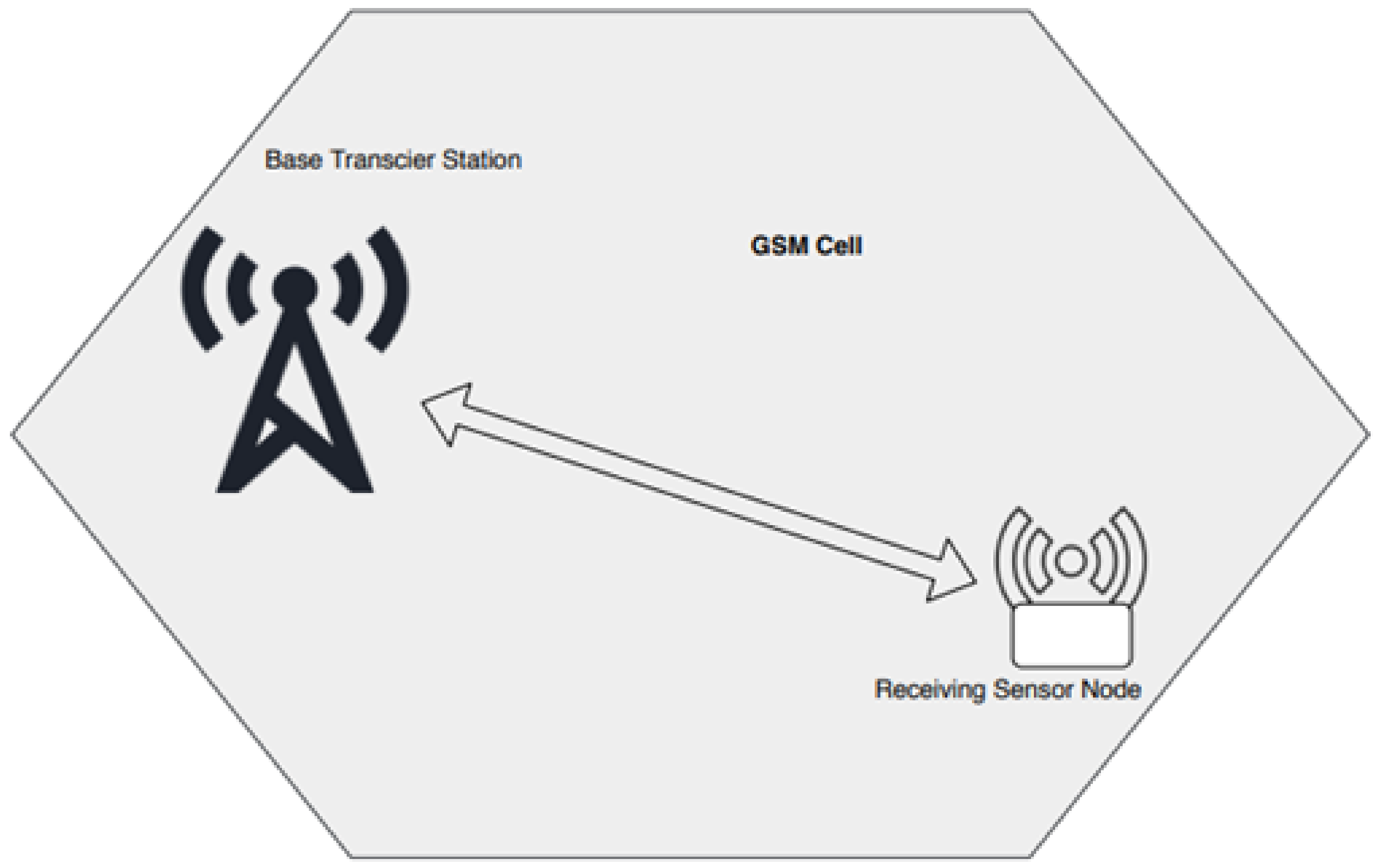
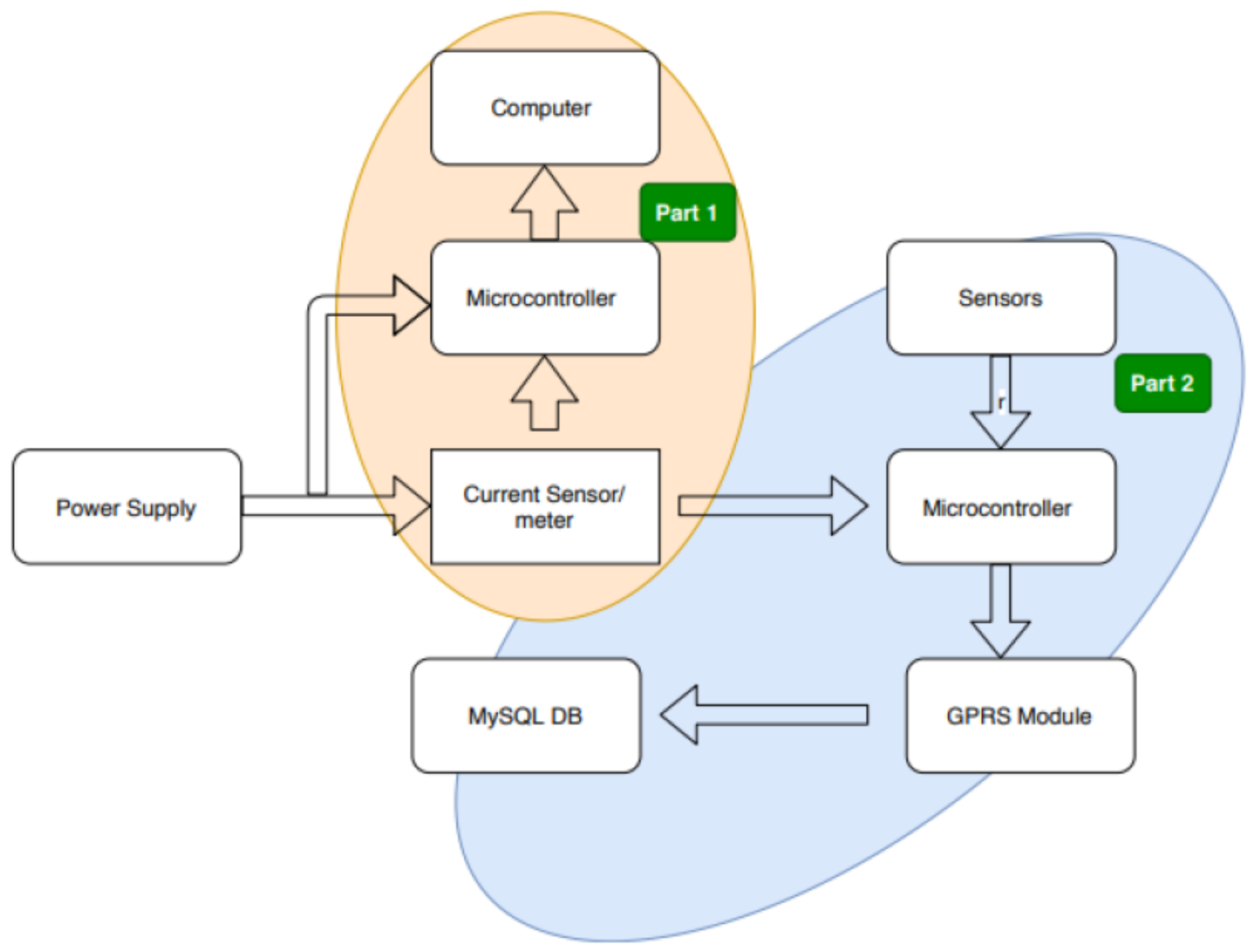

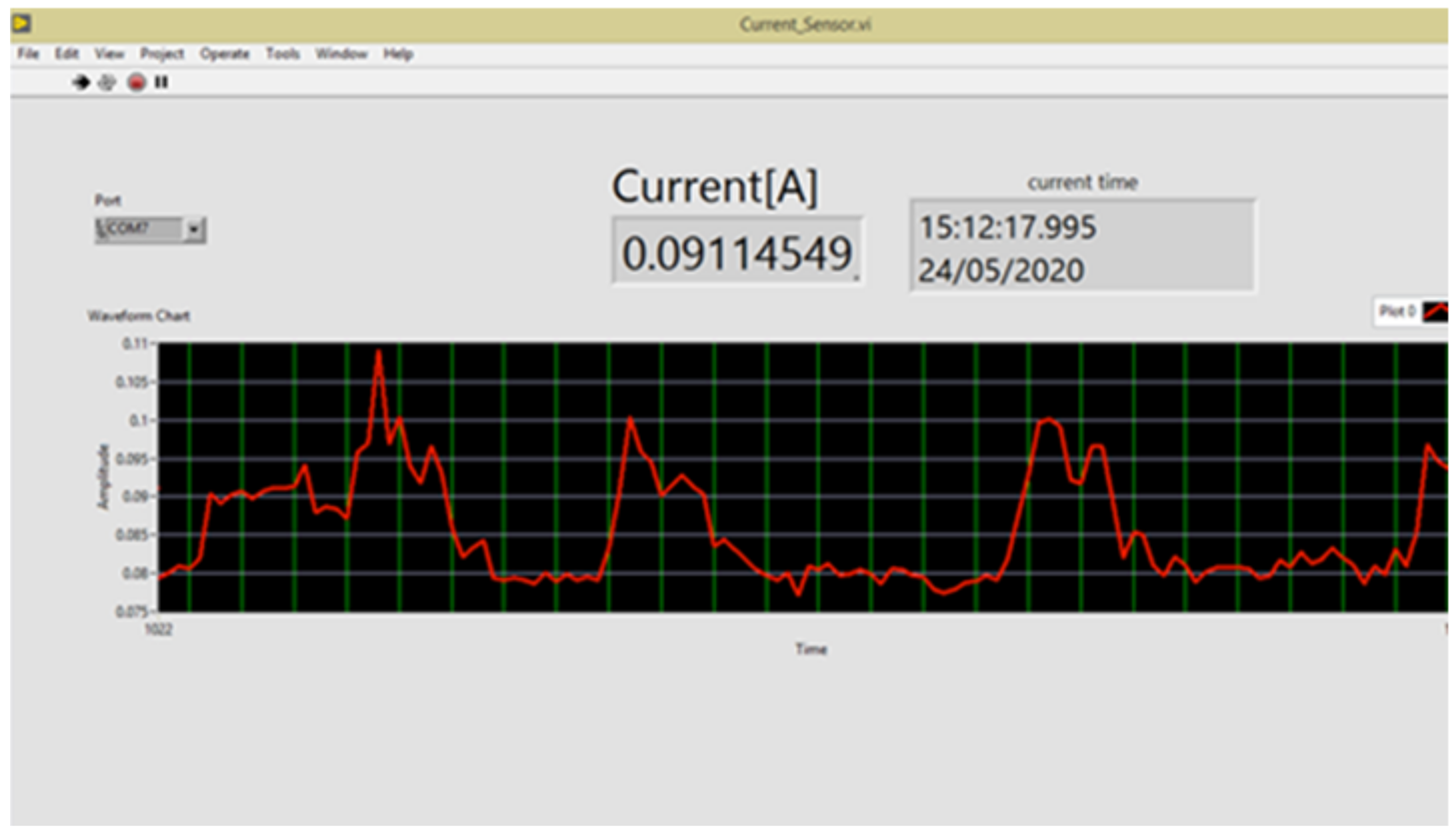
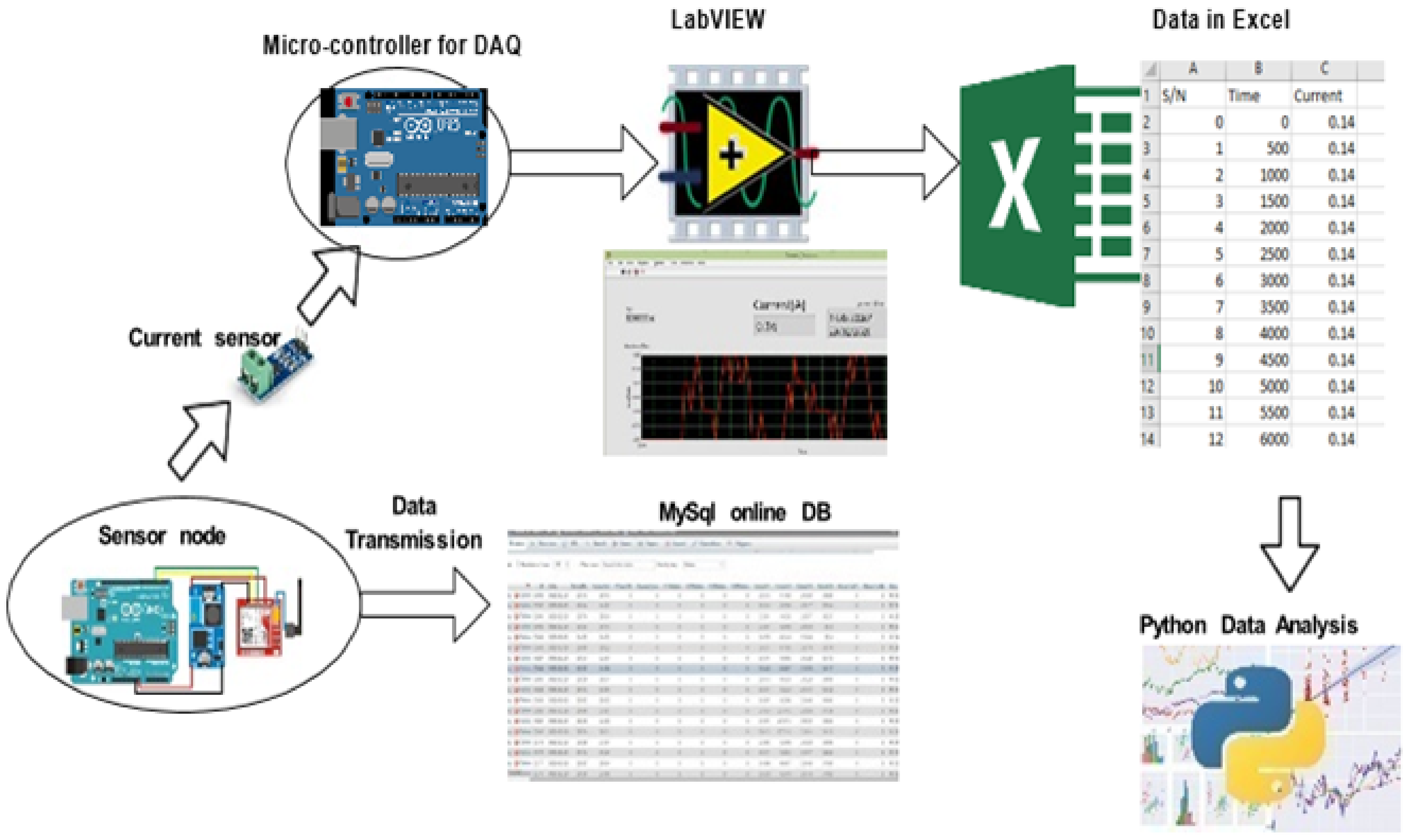
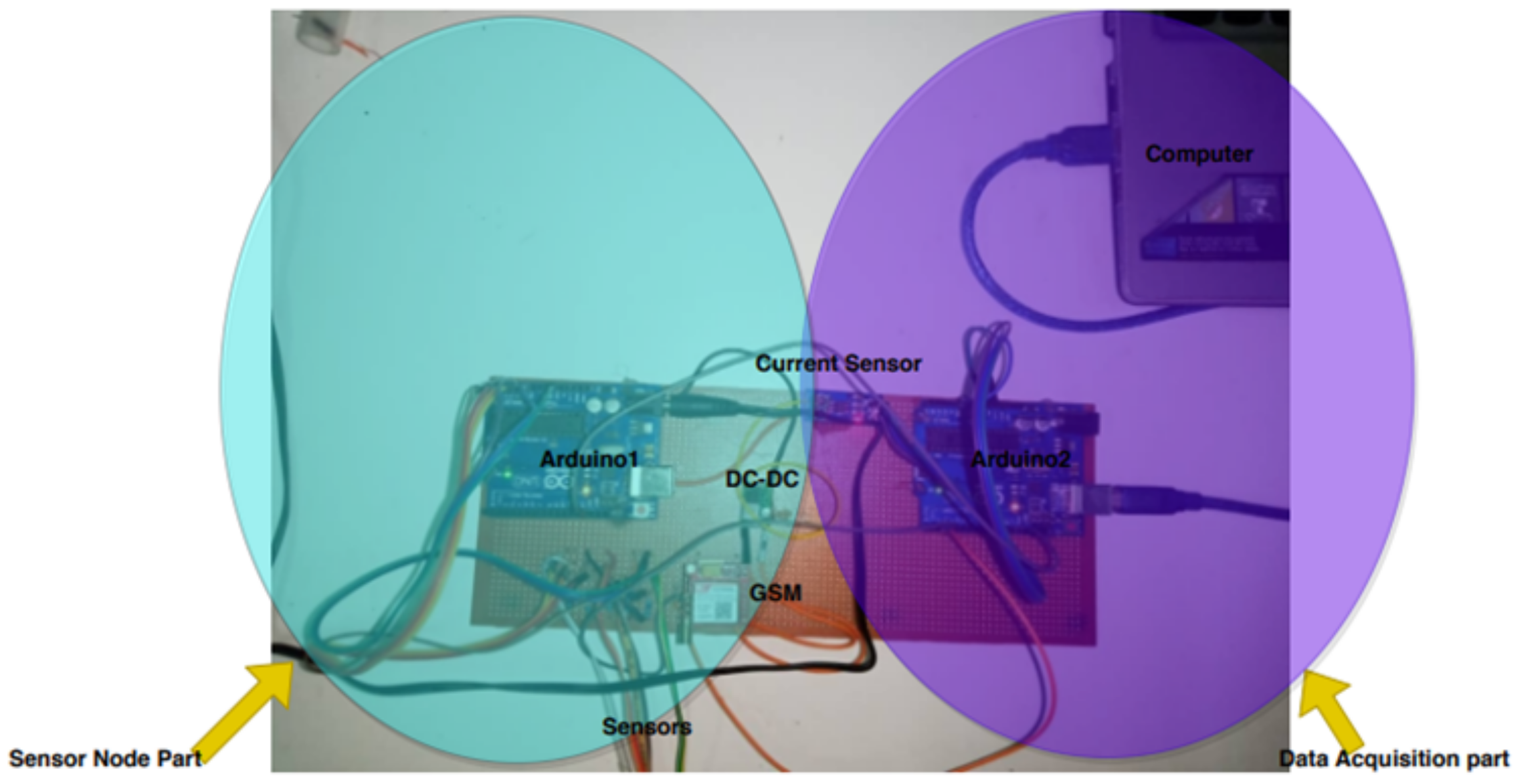


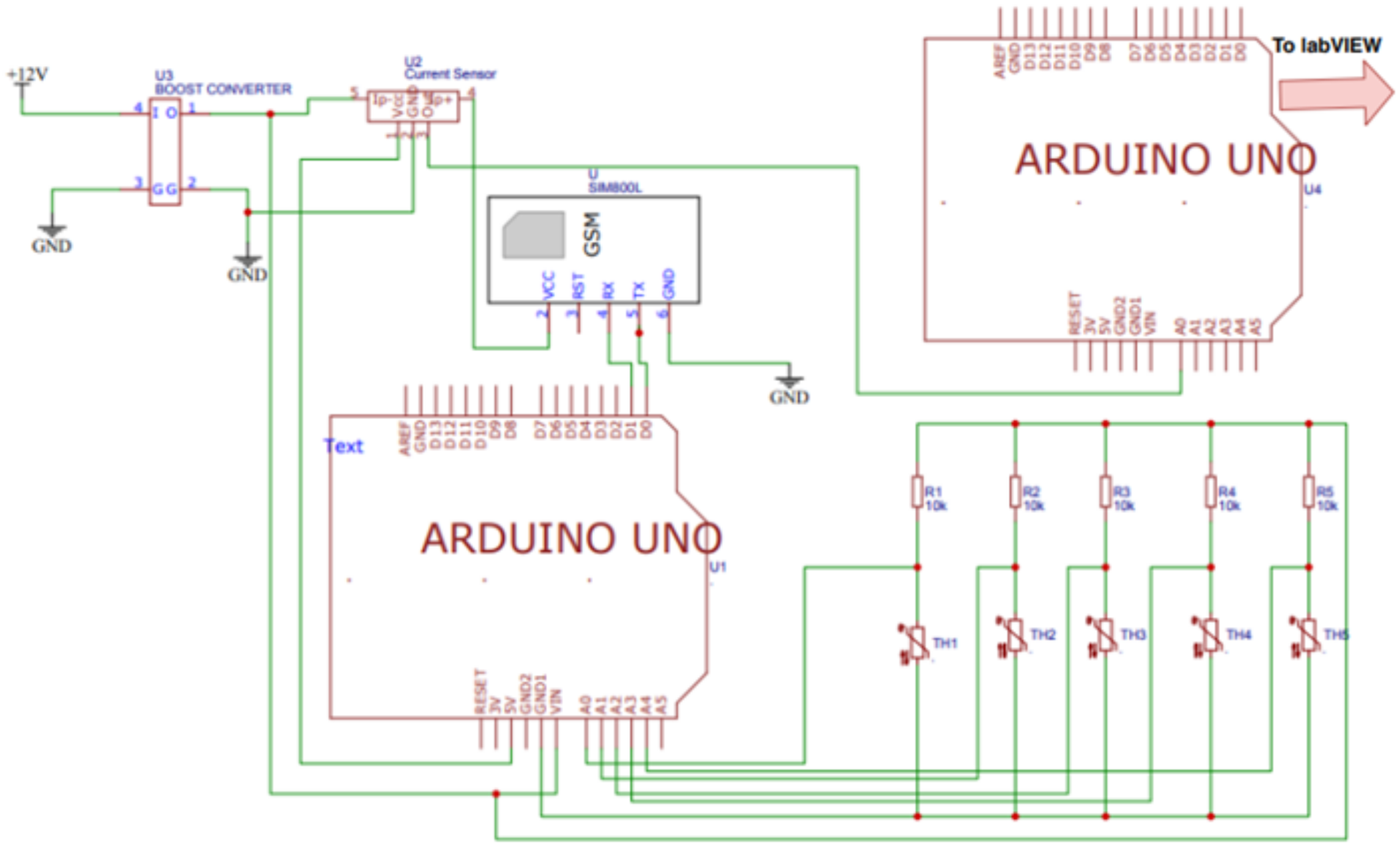

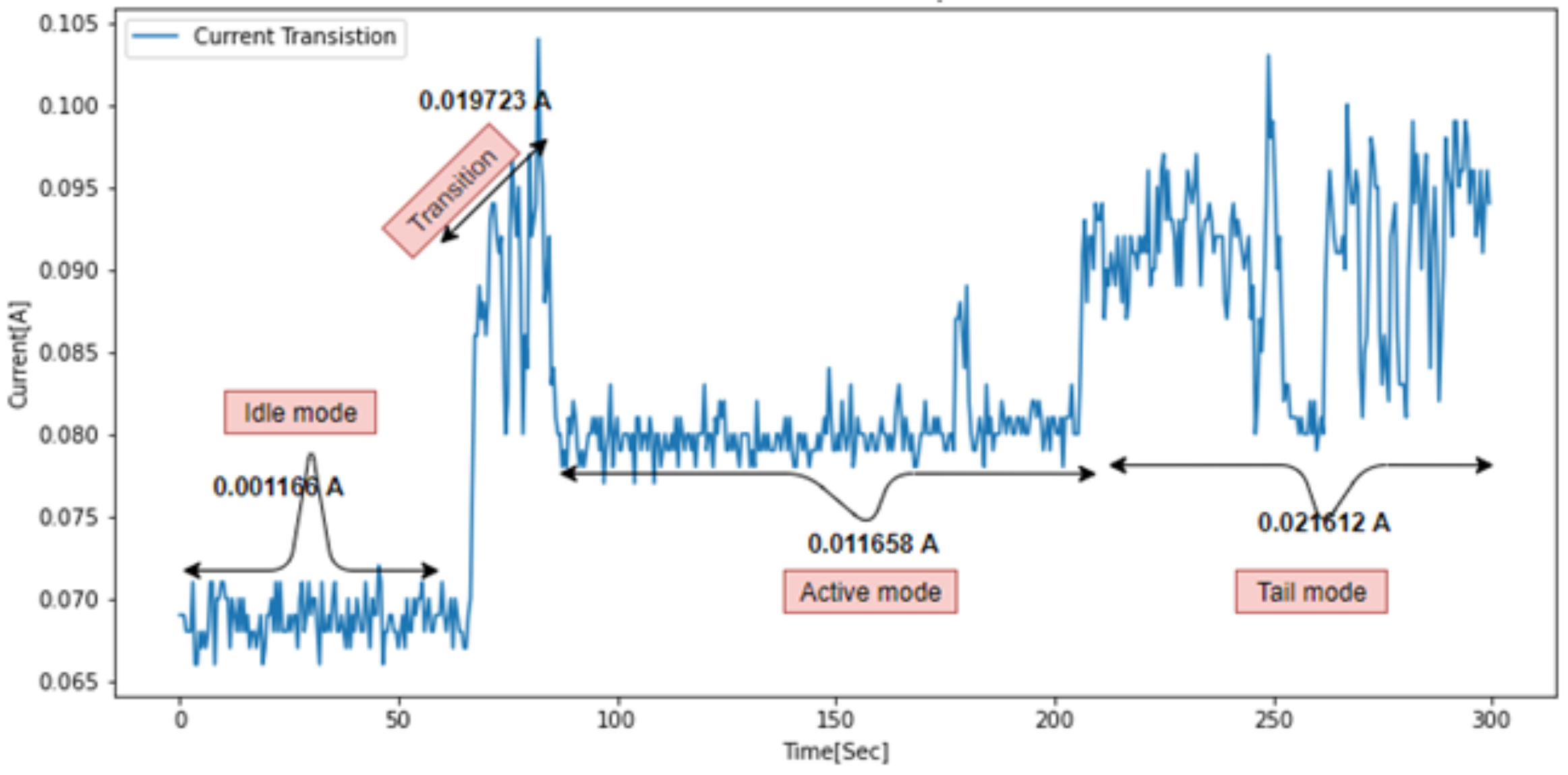
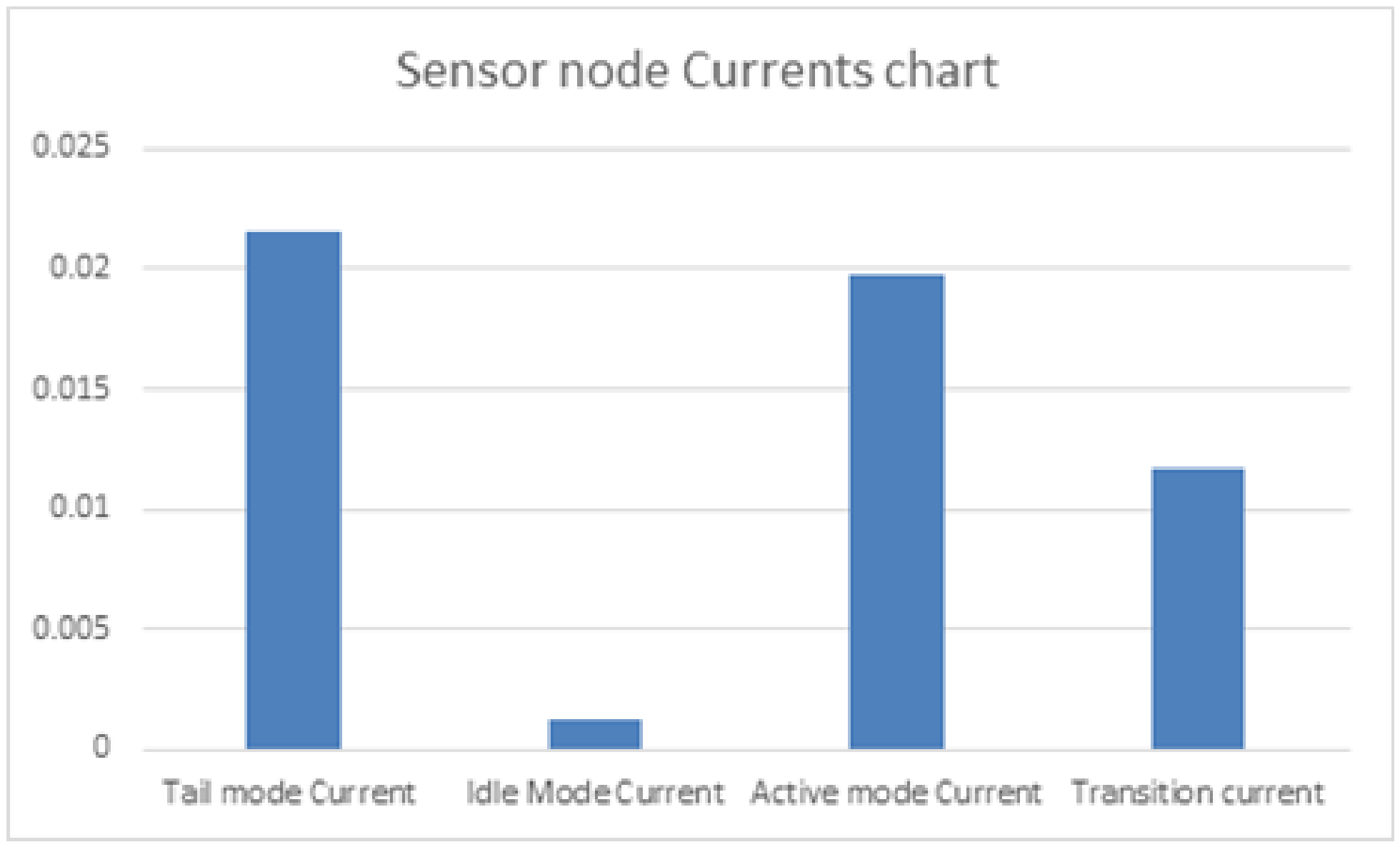
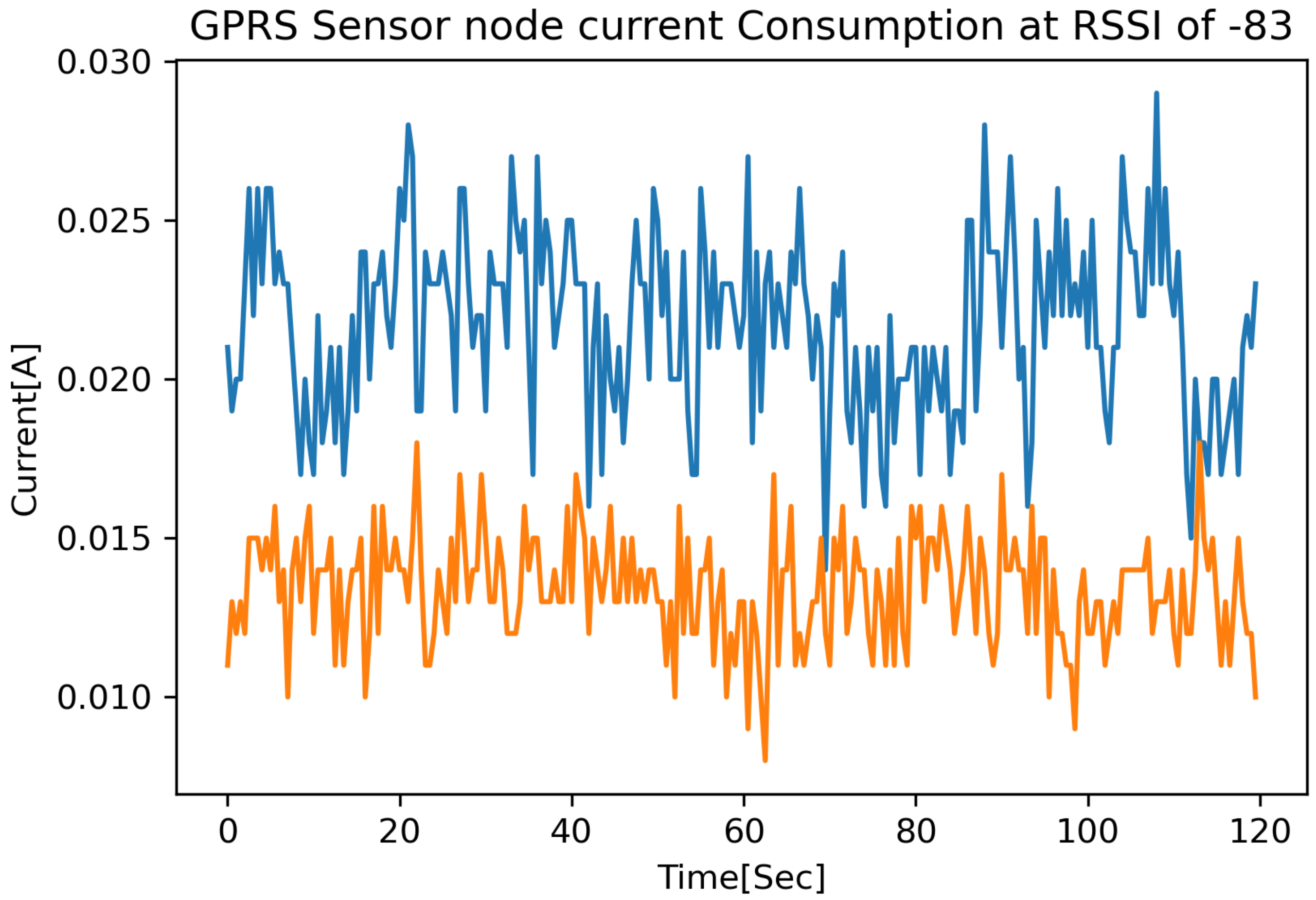

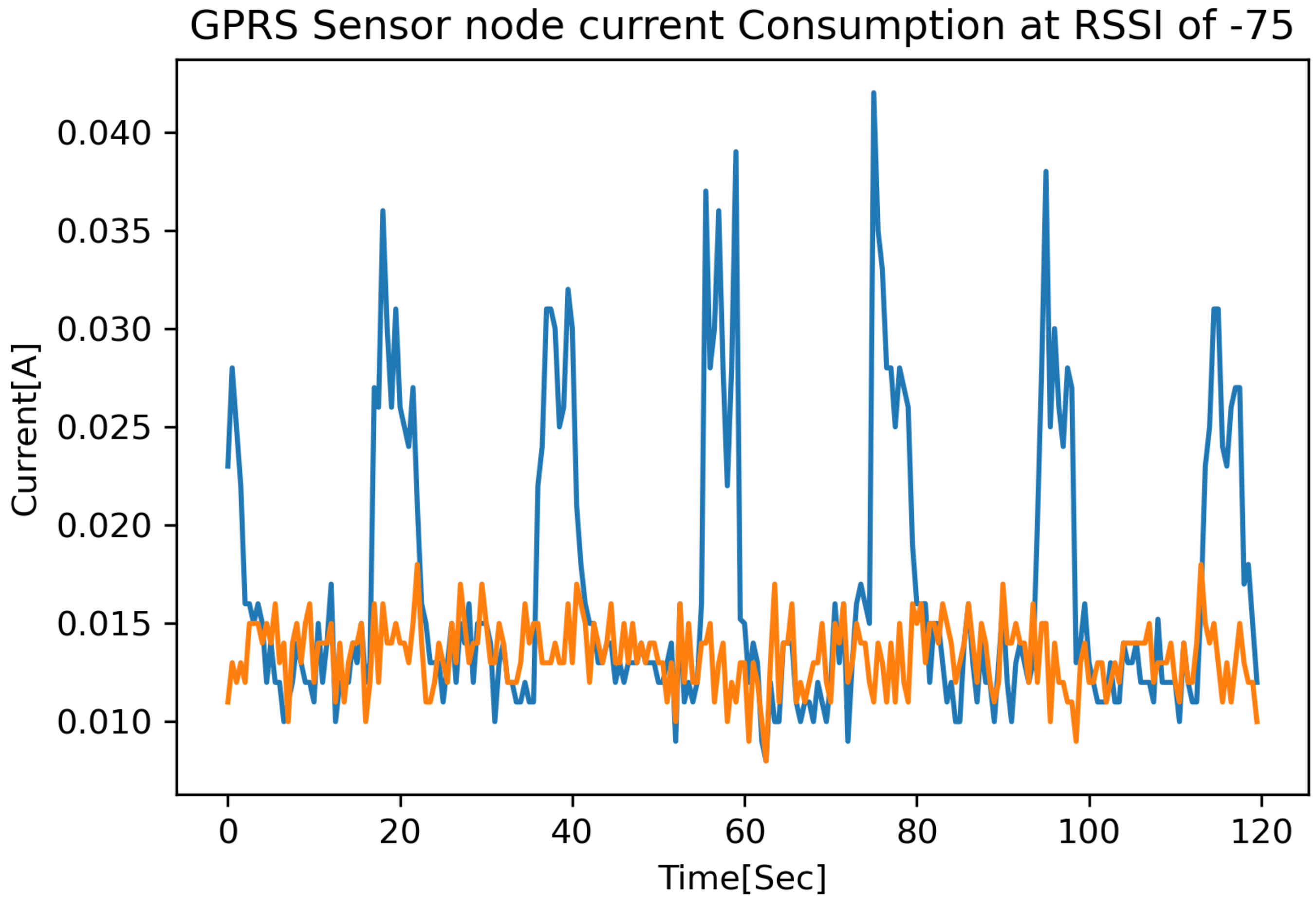
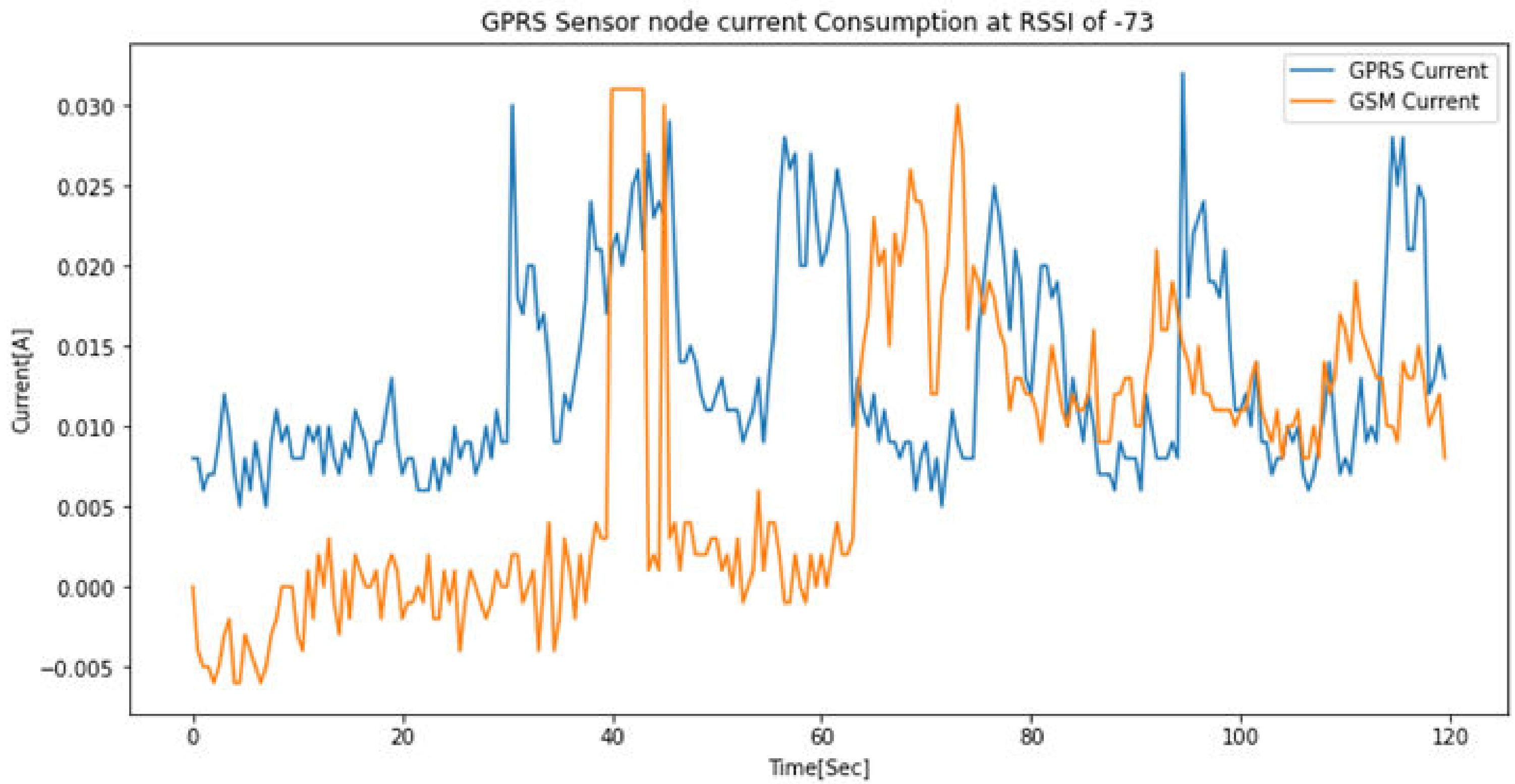
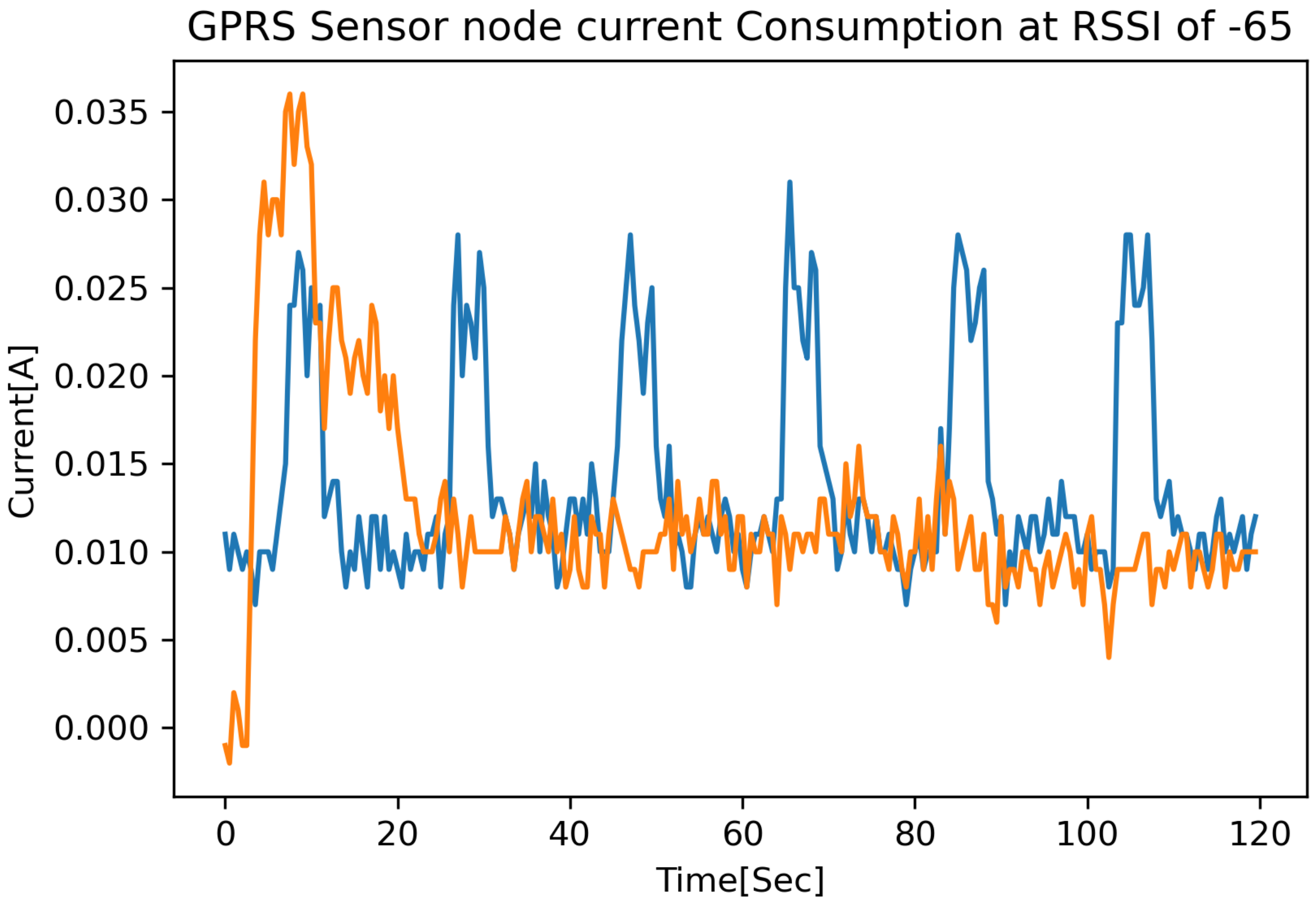
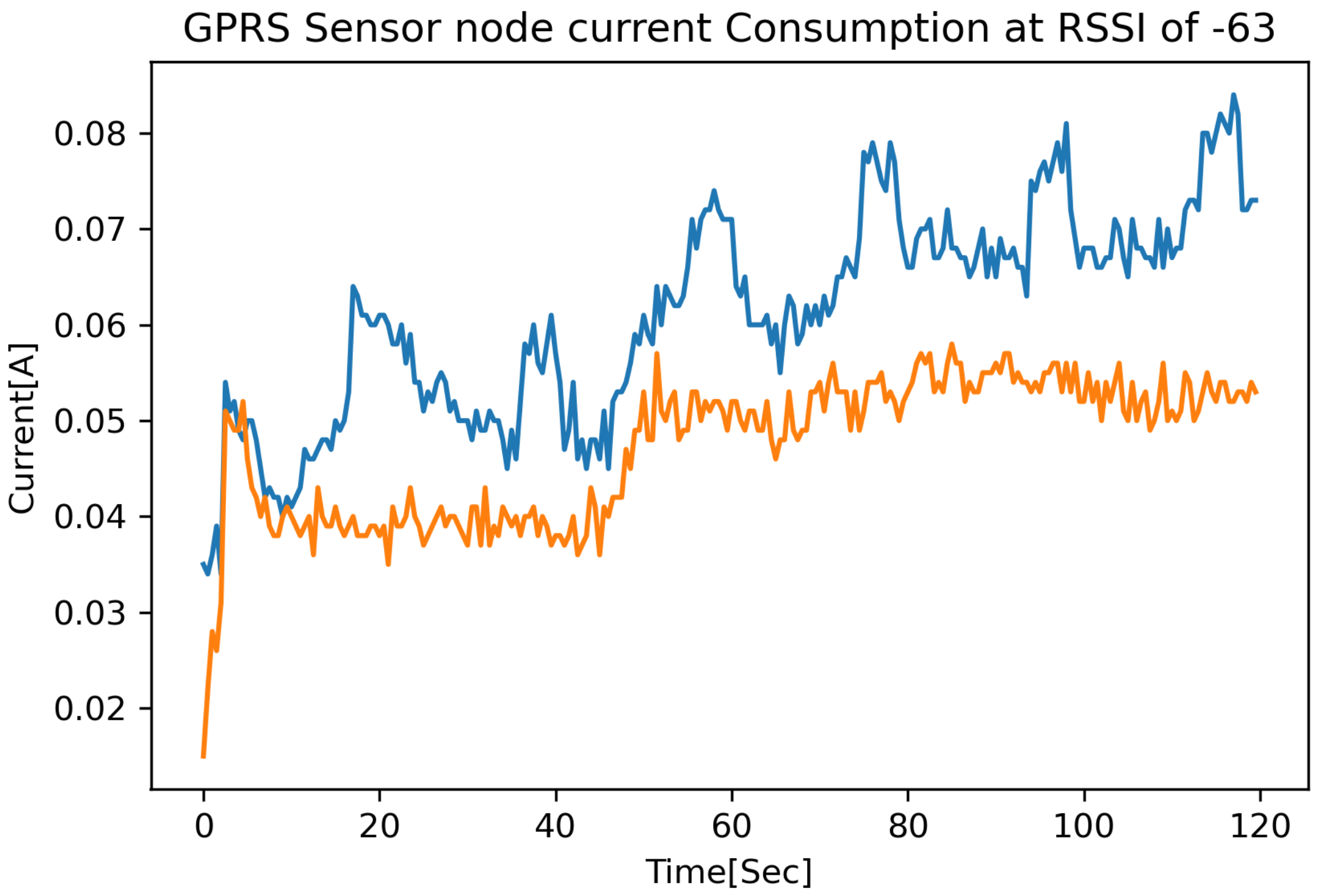
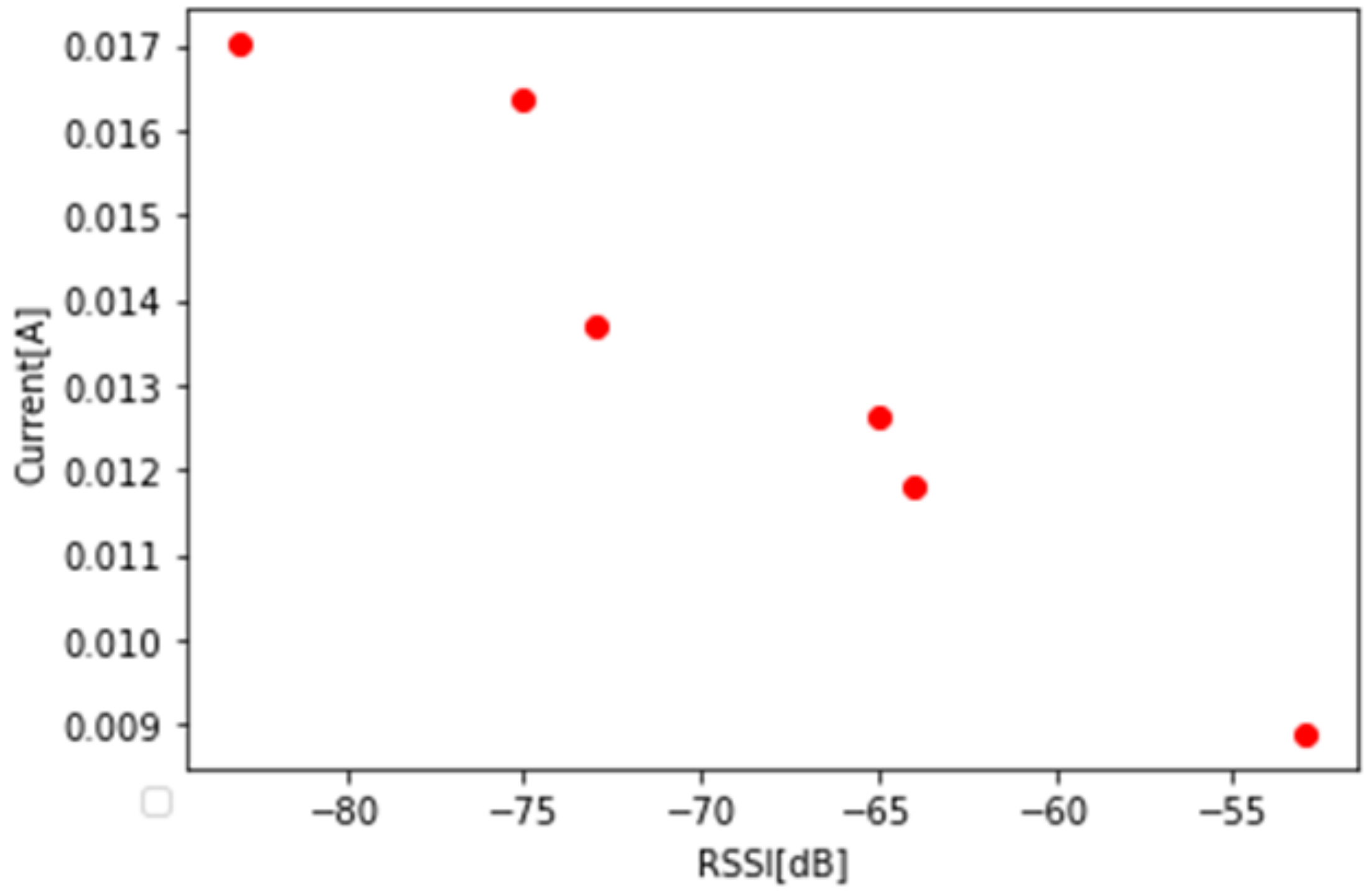
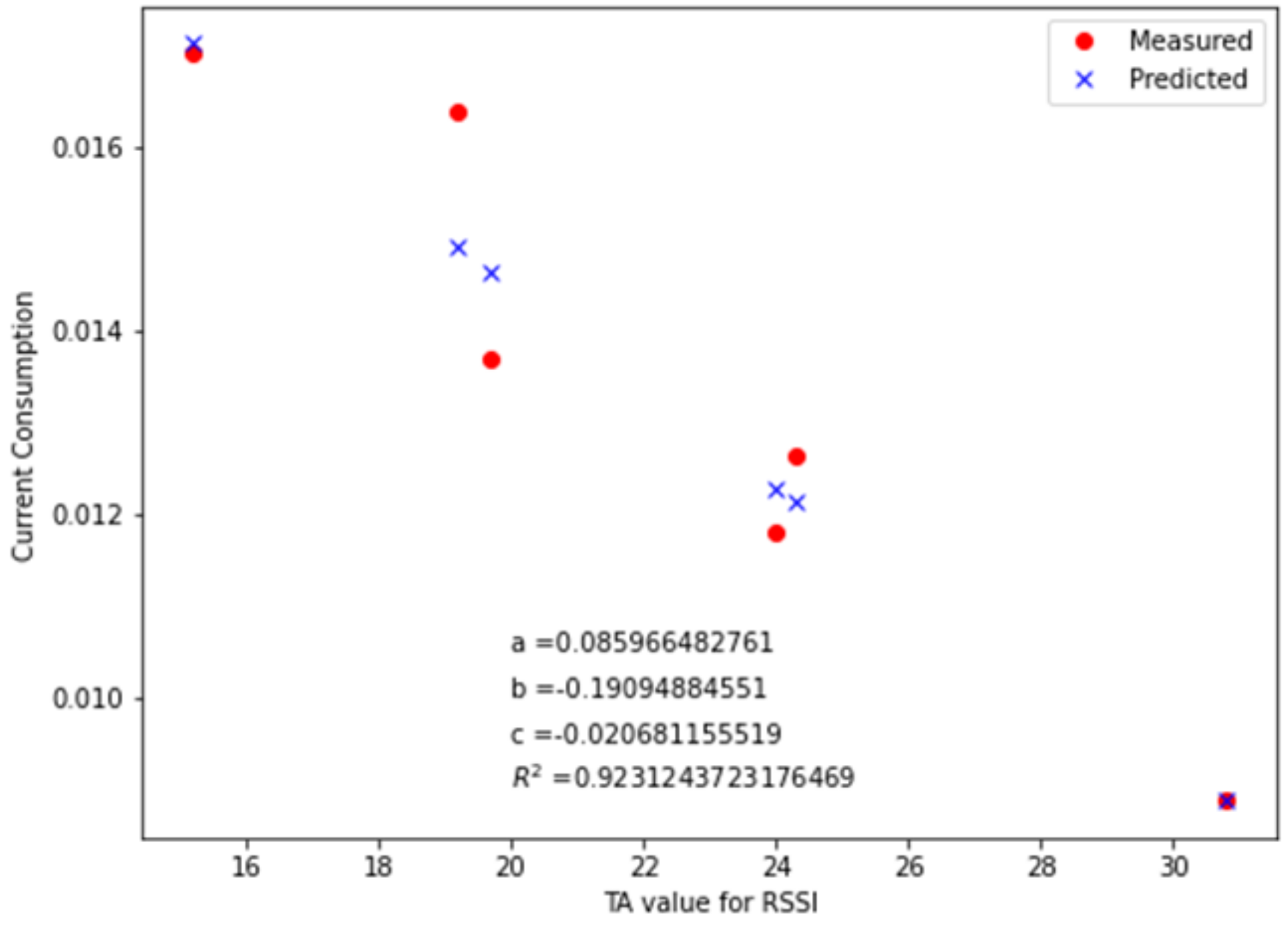
| Feature | Implementation |
|---|---|
| Power supply | 3.4 V–4.4 V |
| Power saving | typical power consumption in sleep mode is 0.7 mA |
| Transmitting power | Class 4 (2 W) at GSM 850 and EGSM 900, Class 1 (1 W) at DCS 1800 and PCS 1900 |
| GPRS connectivity | GPRS multislot class 12(default), GPRS multislot class 1 12 (option) |
| Data GPRS | GPRS data uplink transfer: max. 85.6 kbps |
| SIM interface | Support SIM card: 1.8 V, 3 V |
| External antenna | Full modem interface with status and control lines, unbalanced, asynchronous, 1200 bps to 115,200 bps |
| Applications | AT Command | Explanations |
|---|---|---|
| AT+CREG? | Network cregistration | |
| AT+SAPBR=3,1, | Connecting to GPRS | |
| AT+SAPBR=1,1 | Activation for bear profile | |
| AT Command for GPRS | AT+HTTPINIT | Initialization for HTTP Services |
| AT+HTTPPARA | Set HTTP Parameter values | |
| AT+HTTPACTION | HTTP Method action | |
| AT+HTTPREAD | HTTP Read server response | |
| AT+HTTPTERM | Terminate HTTP Service | |
| AT Command for RSSI | AT+CSQ=? | Signal quality report |
| SN | TA Value | RSSI [dBm] | Condition |
|---|---|---|---|
| 1 | 2 | −109 | Marginal |
| 2 | 3 | −107 | Marginal |
| 3 | 4 | −105 | Marginal |
| 4 | 5 | −103 | Marginal |
| 5 | 6 | −101 | Marginal |
| 6 | 7 | −99 | Marginal |
| 7 | 8 | −97 | Marginal |
| 8 | 9 | −95 | Marginal |
| 9 | 10 | −93 | OK |
| 10 | 11 | −91 | OK |
| 11 | 12 | −89 | OK |
| 12 | 13 | −87 | OK |
| 13 | 14 | −85 | OK |
| 14 | 15 | −83 | Good |
| 15 | 16 | −81 | Good |
| 16 | 17 | −79 | Good |
| 17 | 18 | −77 | Good |
| 18 | 19 | −75 | Good |
| 19 | 20 | −73 | Good |
| 20 | 21 | −71 | Excellent |
| 21 | 22 | −69 | Excellent |
| 22 | 23 | −67 | Excellent |
| 23 | 24 | −65 | Excellent |
| 24 | 25 | −63 | Excellent |
| 25 | 26 | −61 | Excellent |
| 26 | 27 | −59 | Excellent |
| 27 | 28 | −57 | Excellent |
| 28 | 29 | −55 | Excellent |
| 29 | 30 | −53 | Excellent |
| No | Time [s] | GSM-Current [A] | GPRS-Current [A] | RSSI [TA] | RSSI [dBm] | |
|---|---|---|---|---|---|---|
| 1 | 0 | 0.011 | 0.023 | 19 | −75 | |
| 2 | 0.5 | 0.013 | 0.028 | 20 | −73 | |
| 3 | 1 | 0.012 | 0.025 | 19 | −75 | |
| 4 | 1.5 | 0.013 | 0.022 | 19 | −75 | |
| 5 | 2 | 0.012 | 0.016 | 20 | −73 | |
| . | . | . | . | . | . | |
| . | . | . | . | . | . | |
| . | . | . | . | . | . | |
| 172,800 | 86,400 | 0.01 | 0.01 | 19 | −75 | |
| Average | 0.12922551 | 0.016378 | 19.21 | −75 |
| No | Time [s] | GSM-Current [A] | GPRS-Current [A] | RSSI [TA] | RSSI [dBm] | |
|---|---|---|---|---|---|---|
| 1 | 0 | 0.011 | 0.021 | 13 | −87 | |
| 2 | 0.5 | 0.011 | 0.019 | 17 | −80 | |
| 3 | 1 | 0.011 | 0.02 | 18 | −81 | |
| 4 | 1.5 | 0.014 | 0.02 | 18 | −81 | |
| 5 | 2 | 0.014 | 0.023 | 16 | −79 | |
| . | . | . | . | . | . | |
| . | . | . | . | . | . | |
| . | . | . | . | . | . | |
| 172,800 | 86,400 | 0.011 | 0.016 | 14 | −85 | |
| Average | 0.0117 | 0.017014 | 15.20 | −83 |
| No | Time [s] | GSM-Current [A] | GPRS-Current [A] | RSSI [TA] | RSSI [dBm] | |
|---|---|---|---|---|---|---|
| 1 | 0 | 0.014 | 0.009 | 31 | −53 | |
| 2 | 0.5 | 0.016 | 0.008 | 31 | −53 | |
| 3 | 1 | 0.011 | 0.008 | 31 | −53 | |
| 4 | 1.5 | 0.015 | 0.008 | 31 | −53 | |
| 5 | 2 | 0.021 | 0.005 | 31 | −53 | |
| . | . | . | . | . | . | |
| . | . | . | . | . | . | |
| . | . | . | . | . | . | |
| 172,800 | 86,400 | 0.006 | 0.009 | 31 | −53 | |
| Average | 0.0065 | 0.0088 | 31 | −53 |
| No | Time [s] | GSM-Current [A] | GPRS-Current [A] | RSSI [TA] | RSSI [dBm] | |
|---|---|---|---|---|---|---|
| 1 | 0 | 0.011 | 0.008 | 19 | −75 | |
| 2 | 0.5 | 0.007 | 0.008 | 18 | −77 | |
| 3 | 1 | 0.011 | 0.006 | 20 | −73 | |
| 4 | 1.5 | 0.012 | 0.007 | 19 | −75 | |
| 5 | 2 | 0.01 | 0.007 | 21 | −73 | |
| . | . | . | . | . | . | |
| . | . | . | . | . | . | |
| . | . | . | . | . | . | |
| 172,800 | 86,400 | 0.008 | 0.006 | 21 | −71 | |
| Average | 0.0102 | 0.012646 | 20 | −73 |
| No | Time [s] | GSM-Current [A] | GPRS-Current [A] | RSSI [TA] | RSSI [dBm] | |
|---|---|---|---|---|---|---|
| 1 | 0 | 0.01 | 0.011 | 24 | −65 | |
| 2 | 0.5 | 0.022 | 0.009 | 24 | −65 | |
| 3 | 1 | 0.028 | 0.011 | 24 | −65 | |
| 4 | 1.5 | 0.031 | 0.01 | 24 | −65 | |
| 5 | 2 | 0.028 | 0.009 | 24 | −65 | |
| . | . | . | . | . | . | |
| . | . | . | . | . | . | |
| . | . | . | . | . | . | |
| 172,800 | 86,400 | 0.007 | 0.009 | 25 | −63 | |
| Average | 0.0100 | 0.01369 | 24 | −65 |
| No | Time [s] | GSM-Current [A] | GPRS-Current [A] | RSSI [TA] | RSSI [dBm] | |
|---|---|---|---|---|---|---|
| 1 | 0 | 0.015 | 0.035 | 26 | −61 | |
| 2 | 0.5 | 0.022 | 0.034 | 26 | −61 | |
| 3 | 1 | 0.028 | 0.036 | 26 | −61 | |
| 4 | 1.5 | 0.026 | 0.039 | 26 | −61 | |
| 5 | 2 | 0.031 | 0.034 | 26 | −61 | |
| . | . | . | . | . | . | |
| . | . | . | . | . | . | |
| . | . | . | . | . | . | |
| 172,800 | 86,400 | 0.087 | 0.129 | 25 | −63 | |
| Average | 0.0583 | 0.011800 | 25 | −63 |
| Location | Average RSSI [TA] | Average RSSI [dBm] | Average Current [A] |
|---|---|---|---|
| Location 1 | 19.2 | −75 | 0.016378 |
| Location 2 | 15.2 | −83 | 0.017014 |
| Location 3 | 30.8 | −53 | 0.008890 |
| Location 4 | 24.3 | −65 | 0.012646 |
| Location 5 | 19.7 | −73 | 0.013699 |
| Location 6 | 25.48 | −63 | 0.011800 |
Publisher’s Note: MDPI stays neutral with regard to jurisdictional claims in published maps and institutional affiliations. |
© 2020 by the authors. Licensee MDPI, Basel, Switzerland. This article is an open access article distributed under the terms and conditions of the Creative Commons Attribution (CC BY) license (http://creativecommons.org/licenses/by/4.0/).
Share and Cite
Habiyaremye, J.; Zennaro, M.; Mikeka, C.; Masabo, E.; Kumaran, S.; Jayavel, K. GPRS Sensor Node Battery Life Span Prediction Based on Received Signal Quality: Experimental Study. Information 2020, 11, 524. https://doi.org/10.3390/info11110524
Habiyaremye J, Zennaro M, Mikeka C, Masabo E, Kumaran S, Jayavel K. GPRS Sensor Node Battery Life Span Prediction Based on Received Signal Quality: Experimental Study. Information. 2020; 11(11):524. https://doi.org/10.3390/info11110524
Chicago/Turabian StyleHabiyaremye, Joseph, Marco Zennaro, Chomora Mikeka, Emmanuel Masabo, Santhi Kumaran, and Kayalvizhi Jayavel. 2020. "GPRS Sensor Node Battery Life Span Prediction Based on Received Signal Quality: Experimental Study" Information 11, no. 11: 524. https://doi.org/10.3390/info11110524
APA StyleHabiyaremye, J., Zennaro, M., Mikeka, C., Masabo, E., Kumaran, S., & Jayavel, K. (2020). GPRS Sensor Node Battery Life Span Prediction Based on Received Signal Quality: Experimental Study. Information, 11(11), 524. https://doi.org/10.3390/info11110524






